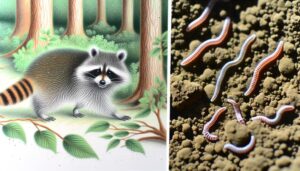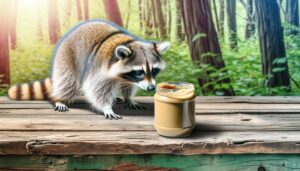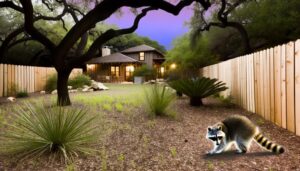How Do Raccoons Like Hummingbird Feeders?
Raccoons are indeed attracted to hummingbird feeders due to the high-calorie, sugary nectar they contain. Their omnivorous diet and nocturnal habits make them prone to seek out easily accessible food sources.
The scent of the nectar coupled with their strong sense of smell further entices them. Raccoons often damage feeders by gnawing on plastic components and spilling nectar, which can attract other pests.
To mitigate these issues, effective placement and deterrent strategies are essential. If you want to manage raccoon interactions around your feeders more effectively, there are several methods and considerations to explore further.
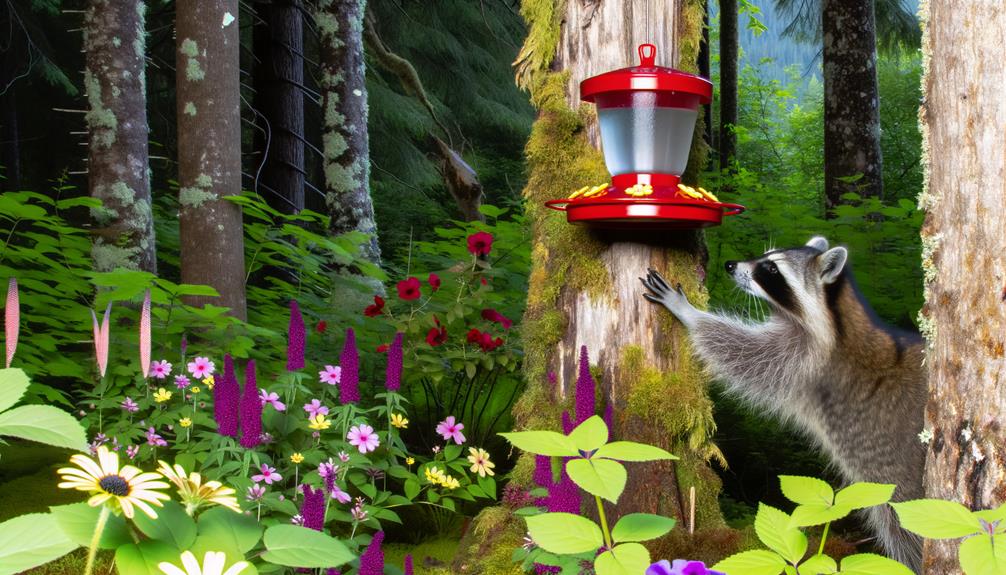
Key Takeaways
- Raccoons are attracted to the high-calorie content of hummingbird nectar.
- Their nocturnal foraging habits increase the likelihood of encountering hummingbird feeders.
- Raccoons can easily gnaw through plastic feeders using their strong teeth.
- Spilled nectar from raccoon interference attracts pests and requires frequent cleaning.
- Proper feeder placement and deterrents can prevent raccoon access to hummingbird feeders.
Raccoons' Eating Habits

Raccoons (Procyon lotor) exhibit omnivorous feeding behaviors, consuming a diverse diet that includes fruits, vegetables, insects, and small vertebrates. Their dietary flexibility allows them to adapt to various habitats, from forests to urban areas.
In the wild, raccoons forage for nuts, berries, and acorns, while also preying on amphibians, birds, and fish. Their opportunistic feeding strategy extends to scavenging, often raiding human garbage and compost bins. Raccoons possess dexterous front paws, enabling them to manipulate food items with remarkable precision.
Seasonality influences their diet, with a higher reliance on fruits and vegetables during summer and autumn, and increased consumption of animal matter in colder months. This dietary adaptability is essential for their survival across diverse environments.
What Attracts Raccoons
Raccoons are primarily attracted to environments that provide sweet food sources, such as fruit and nectar, which can include the contents of hummingbird feeders.
Additionally, the presence of accessible water supplies and secure shelter further entices these nocturnal mammals.
Understanding these factors is essential for managing raccoon interactions with backyard feeders and other attractants.
Sweet Food Sources
The attraction of raccoons to various environments can often be attributed to their preference for sweet food sources, which include the sugary nectar found in hummingbird feeders. Raccoons possess a highly developed sense of taste and smell, making them adept at locating sweet treats.
Their omnivorous diet benefits from high-energy foods, including fruits, berries, and artificial sources of sugar. Research indicates that raccoons are particularly drawn to the sucrose present in nectar, which provides a quick energy boost. This preference explains why raccoons frequently target hummingbird feeders, especially in suburban areas where natural food sources may be limited.
Understanding these dietary inclinations is essential for managing raccoon encounters and mitigating potential disruptions to backyard ecosystems.
Accessible Water Supplies
Given their need for hydration and preference for easily obtainable resources, accessible water supplies are a significant attractant for raccoons. These nocturnal mammals are opportunistic foragers and seek out water sources that are readily available.
Birdbaths, pet water bowls, and even the sugary liquid in hummingbird feeders can serve as hydration points. The presence of water not only meets their physiological needs but also supports their dietary habits, which include a variety of wet and dry foods.
Moreover, raccoons' dexterous forepaws allow them to manipulate objects and access confined water sources, making them adept at exploiting human-provided water supplies. Hence, maintaining secure and limited access to water sources is essential in mitigating raccoon intrusion.
Shelter and Safety
Frequently seeking environments that offer both cover and protection, raccoons are naturally drawn to areas that provide ample shelter and safety. Dense vegetation, hollow trees, and abandoned structures serve as ideal habitats, allowing raccoons to evade predators and harsh weather conditions.
These nocturnal mammals exhibit a preference for secluded areas that facilitate undisturbed foraging and nesting. Urban settings, with their myriad hiding spots such as attics, garages, and crawl spaces, also attract raccoons. The availability of such shelters in proximity to food sources, including hummingbird feeders, enhances the appeal of these environments.
Understanding the shelter needs of raccoons can aid in devising effective wildlife management strategies to mitigate their impact on residential areas and ecological systems.
Hummingbird Feeder Appeal
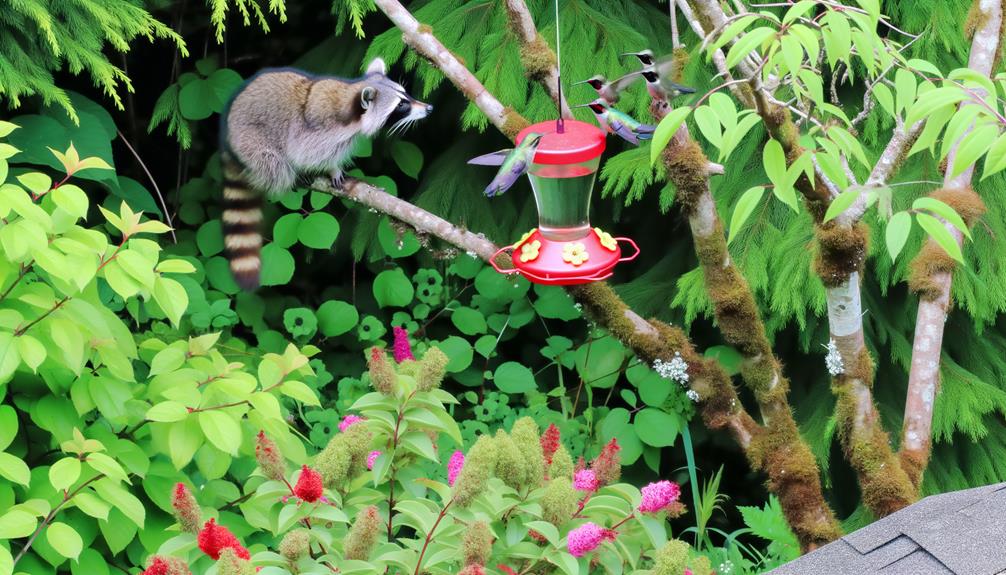
Hummingbird feeders are designed to attract birds through the provision of sweet nectar, which serves as a high-energy food source.
The bright colors of these feeders, typically in hues of red and yellow, mimic natural floral cues that are visually stimulating to both hummingbirds and other wildlife.
These two features, the sweetness of the nectar and the vivid coloration, contribute notably to the feeder's appeal to raccoons.
Sweet Nectar Attraction
Raccoons are naturally drawn to the sweet nectar found in hummingbird feeders due to their opportune feeding behavior and keen sense of smell. This attraction is primarily driven by the high sugar content of the nectar, which provides a rich energy source.
Raccoons possess highly sensitive olfactory receptors, allowing them to detect the sugary scent from considerable distances. Additionally, their skillful forepaws enable them to easily manipulate feeders to access the nectar. The combination of these traits makes hummingbird feeders a frequent target for raccoons, especially in urban and suburban environments where natural food sources may be limited.
Consequently, understanding this behavior is vital for those who seek to protect their feeders from raccoon interference while ensuring the well-being of the local hummingbird population.
Bright Colors Fascination
Due to their visual acuity, raccoons are often captivated by the bright colors of hummingbird feeders, which are designed to attract hummingbirds but inadvertently appeal to other wildlife as well.
The vivid reds, yellows, and pinks commonly used in these feeders mimic the natural floral hues that hummingbirds find irresistible. Raccoons, possessing a moderate level of color vision, can distinguish these bright colors, leading to increased curiosity and interaction.
This attraction is compounded by the feeders' conspicuous location and accessibility. Consequently, raccoons may investigate these objects, driven by both visual stimuli and the potential promise of sweet nectar.
Understanding this behavior is essential for managing wildlife interactions and ensuring the effectiveness of bird feeding strategies.
Signs of Raccoon Activity
Indicators of raccoon presence around hummingbird feeders often include scattered remnants of feeder contents, overturned feeders, and distinctive paw prints. Raccoons are nocturnal omnivores with dexterous forepaws capable of manipulating objects, evidenced by their characteristic five-toed prints often found in soft soil or mud. Additionally, they are known to climb and reach elevated positions, indicating their ability to access feeders placed at considerable heights.
Shredded or displaced vegetation near feeders can also suggest raccoon activity, as they often trample surrounding flora while foraging. Observing these signs can help in identifying raccoon activity, thereby facilitating appropriate measures to mitigate their impact on hummingbird feeders. Consistent monitoring and recording of these indicators are essential for conclusive identification of raccoon involvement.
Common Feeder Damages

Damage to hummingbird feeders is a common issue when raccoons are involved. Typical signs include chewed feeder ports, spilled nectar, and bent hanger rods, all of which compromise the functionality of the feeder.
Understanding these damages can aid in developing effective strategies for raccoon deterrence and feeder maintenance.
Chewed Feeder Ports
Chewed feeder ports on hummingbird feeders are indicative of raccoon activity, as these nocturnal mammals often gnaw on the plastic components to access the sugary liquid inside. This behavior results in significant damage, rendering the feeders less effective and requiring frequent replacement.
The primary reasons for this damage include:
- Nutritional Need: Raccoons are attracted to the high-calorie content of hummingbird nectar, which provides a quick energy source.
- Dexterous Paws: Raccoons possess highly dexterous front paws, allowing them to manipulate and chew feeder parts with ease.
- Nocturnal Foraging: Their nighttime foraging habits increase the likelihood of encountering and damaging feeders under the cover of darkness.
- Plastic Vulnerability: The plastic materials commonly used in feeder construction are easily gnawed through by raccoons' strong teeth.
Spilled Nectar Mess
In addition to chewed feeder ports, raccoon interference often results in spilled nectar, creating a sticky mess that attracts other pests and requires frequent cleaning.
This spilled nectar can attract ants, bees, and wasps, which further complicates the maintenance of hummingbird feeders. The sugary substance can also promote mold and bacterial growth, posing potential health risks for the hummingbirds.
Frequent spillage requires additional labor to clean not only the feeder itself but also the surrounding areas. This task is essential to make sure that the environment remains safe and attractive for hummingbirds.
The recurrent cleanup can become a significant burden for bird enthusiasts, highlighting the need for effective deterrence methods to prevent raccoons from accessing the feeders.
Bent Hanger Rods
Raccoons often cause significant damage to hummingbird feeders by bending the hanger rods, which compromises the stability and functionality of the feeders. This structural deformation primarily occurs due to the raccoons' weight and their manipulative dexterity.
Key impacts of bent hanger rods include:
- Reduced Stability: Bent rods cause feeders to hang unevenly, increasing the likelihood of spills.
- Inaccessibility: Deformed rods may place feeders in positions where hummingbirds cannot easily access them.
- Increased Wear: Continuous bending weakens the rods' material over time, leading to potential breakage.
- Maintenance Challenges: Fixing or replacing bent rods requires additional time and resources, complicating feeder upkeep.
Understanding these impacts is essential for devising effective strategies to protect hummingbird feeders from raccoon interference.
Seasonal Feeding Patterns
Seasonal feeding patterns of raccoons reveal significant variations in their interaction with hummingbird feeders. These patterns are heavily influenced by changes in food availability and environmental conditions. During the spring and summer months, raccoons exhibit increased nocturnal activity as they seek supplemental food sources to support their higher energy needs. Hummingbird feeders, often rich in sugar water, become prime targets.
Conversely, in the late fall and winter, raccoon activity around these feeders diminishes due to the availability of alternative natural food sources and lower metabolic demands. Additionally, raccoons may exhibit opportunistic behavior in urban settings where human-provided food is more consistently available.
Understanding these seasonal patterns is essential for managing raccoon interactions with hummingbird feeders effectively and maintaining ecological balance.
Preventing Raccoon Access
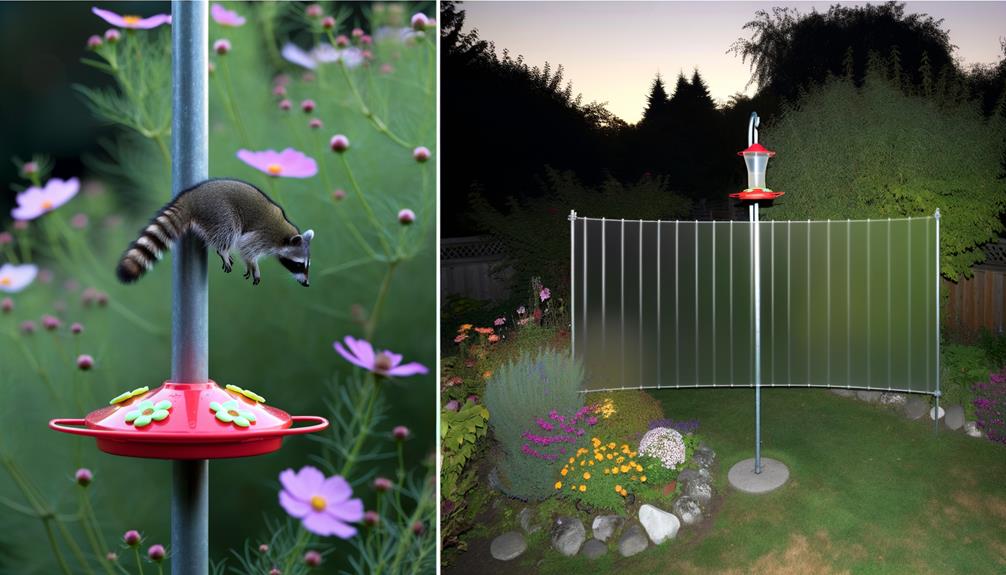
Implementing effective strategies to prevent raccoons from accessing hummingbird feeders is essential for preserving the feeders' intended purpose and minimizing wildlife disturbances. Raccoons are adept climbers and problem-solvers, requiring robust deterrents.
Consider the following methods:
- Baffles: Install baffles, which are dome-shaped barriers, on poles to obstruct raccoon climbing.
- Hanging Mechanisms: Utilize thin, slippery wires or fishing lines to suspend feeders, making it difficult for raccoons to grasp.
- Scent Deterrents: Apply raccoon repellents such as predator urine or capsaicin around the feeder area to dissuade their approach.
- Feeder Design: Opt for feeders with built-in raccoon guards or those that can be securely closed to prevent access.
These strategies collectively enhance feeder protection and promote uninterrupted hummingbird activity.
Feeder Placement Tips
Positioning hummingbird feeders strategically is essential to guaranteeing they remain accessible to hummingbirds while deterring unwanted wildlife intrusions. Placing feeders at least 10-12 feet above ground can minimize raccoon access, as these animals are skilled climbers but may struggle with higher placements. Additionally, positioning feeders away from trees and structures can reduce the likelihood of raccoons reaching them.
| Factor | Recommendation |
|---|---|
| Height | 10-12 feet above ground |
| Proximity | Away from trees and structures |
| Visibility | Visible to hummingbirds, concealed from predators |
| Accessibility | Easy for humans to refill and clean |
These measures guarantee that feeders are accessible to hummingbirds while minimizing the risk of raccoon interference. Proper placement is pivotal in maintaining the integrity and functionality of hummingbird feeders.
Raccoon Deterrents
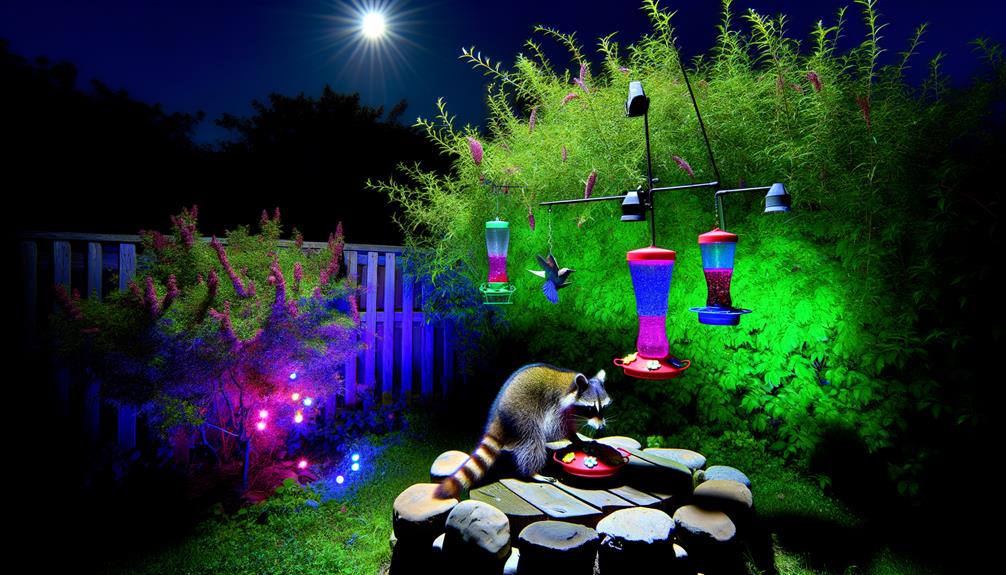
Effectively deterring raccoons from accessing hummingbird feeders requires a multifaceted approach that combines physical barriers, repellents, and strategic placement. These methods can substantially reduce the likelihood of raccoon interference.
Key deterrent strategies include:
- Install Baffles: Attach baffles to poles supporting feeders to prevent raccoons from climbing.
- Use Repellents: Apply raccoon-specific repellents around feeder bases, ensuring they are safe for hummingbirds.
- Elevate Feeders: Position feeders at least 10 feet high and 4 feet away from any structure raccoons could climb.
- Secure Feeders: Utilize feeders with locking mechanisms to prevent raccoons from opening them.
Implementing these measures can effectively safeguard hummingbird feeders from raccoon interference, ensuring uninterrupted feeding for hummingbirds.
Alternative Feeding Solutions
Exploring alternative feeding solutions can provide a raccoon-free environment while still catering to the dietary needs of hummingbirds. One effective method involves employing specialized feeders designed to be inaccessible to larger mammals.
Tube feeders with narrow feeding ports can limit access, ensuring only hummingbirds benefit from the nectar. Additionally, placing feeders on tall poles equipped with baffles can deter raccoons from climbing.
Another strategy includes using saucer-style feeders that are harder for raccoons to manipulate. Lastly, relocating feeders to open areas away from trees and structures, which raccoons use to bridge gaps, minimizes their access.
These alternative solutions aim to maintain hummingbird feeding efficacy while mitigating the risk of raccoon interference.
Monitoring Wildlife Activity
Monitoring wildlife activity involves the systematic observation and recording of animal behavior and movements around hummingbird feeders to identify patterns and potential threats. This process aids in understanding interactions between raccoons and feeders, thereby informing effective management strategies.
Key components of such monitoring include:
- Camera Surveillance: Utilizing motion-sensor cameras to capture nocturnal and diurnal activity.
- Data Logging: Recording the frequency and time of visits to identify peak activity periods.
- Behavioral Analysis: Studying footage to discern specific behaviors, such as feeding or tampering with the feeder.
- Environmental Assessments: Examining surrounding habitat conditions that may attract raccoons to the area.
These methodologies offer a thorough approach for evaluating the impact of raccoons on hummingbird feeders, ensuring data-driven solutions.
Conclusion
The raccoon's nocturnal incursions, reminiscent of the cunning of Odysseus, pose significant threats to hummingbird feeders. Evidence of their activity includes telltale damage, displaced feeders, and spilled nectar.
Strategic feeder placement and the implementation of deterrents, such as baffles and motion-activated lights, are imperative to safeguard these avian sanctuaries. By understanding raccoons' behavioral patterns and employing meticulous preventive measures, one can mitigate the impact on hummingbird feeding stations, ensuring the preservation of this delicate ecological interaction.

